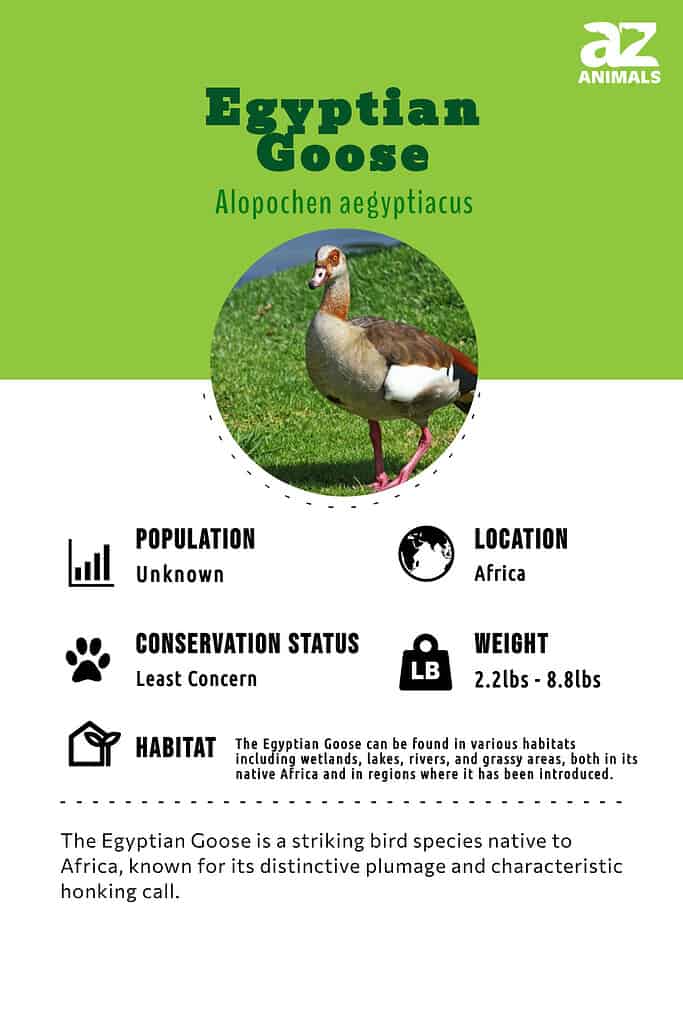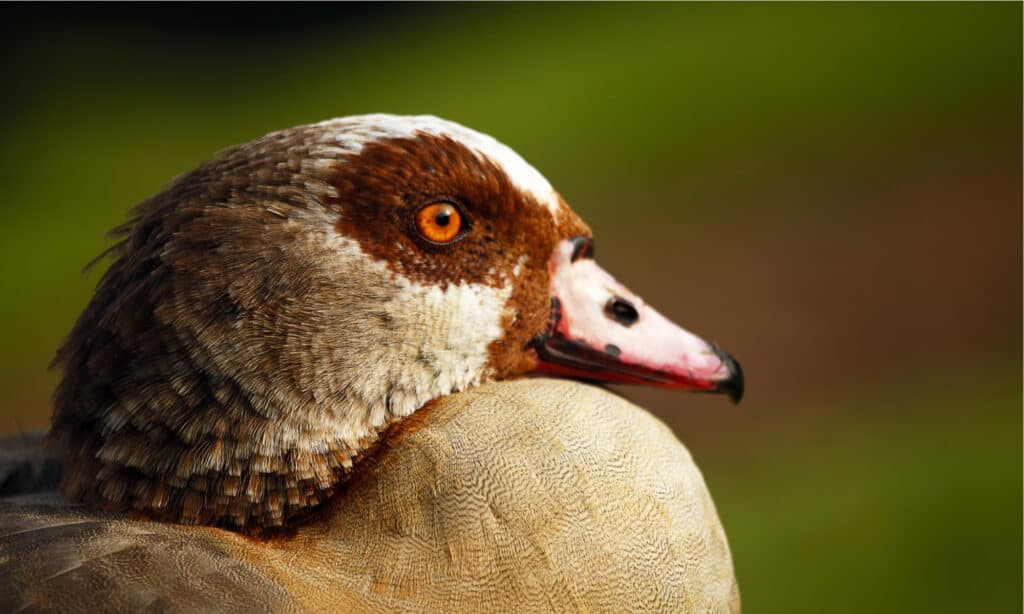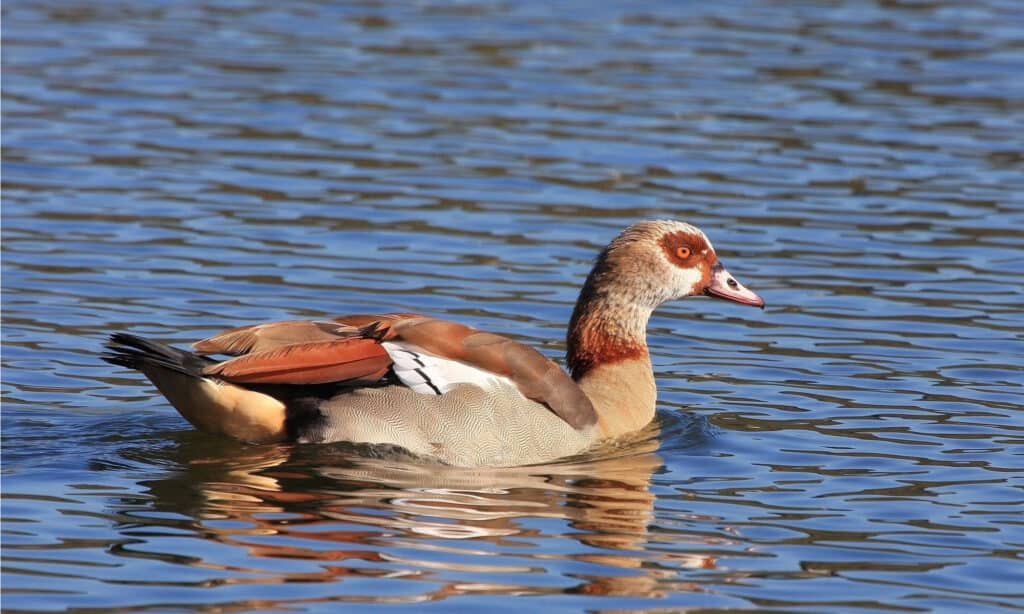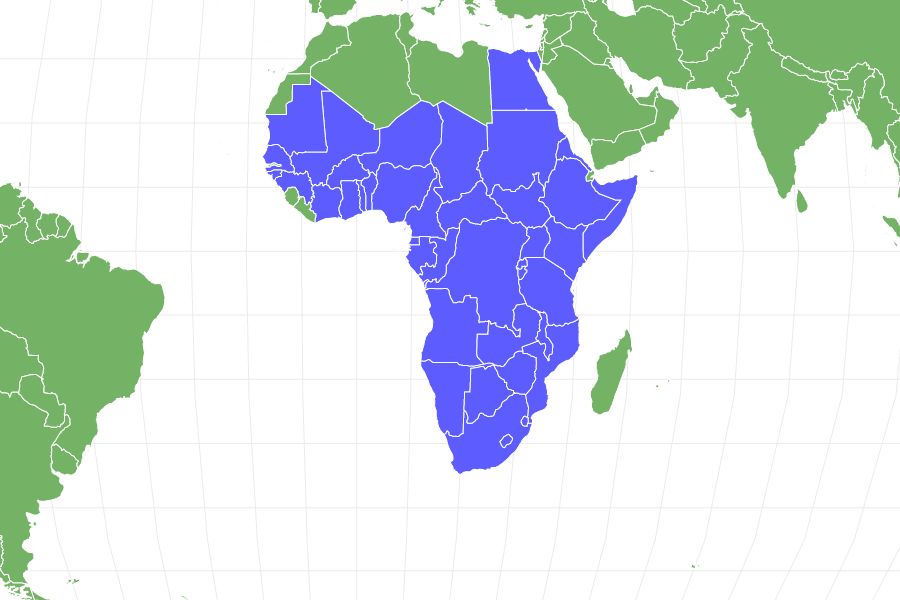Egyptian Goose
Alopochen aegyptiacus
A duck species that resembles a goose when flying
Advertisement
Egyptian Goose Scientific Classification
- Kingdom
- Animalia
- Phylum
- Chordata
- Class
- Aves
- Order
- Anseriformes
- Family
- Anatidae
- Genus
- Alopochen
- Scientific Name
- Alopochen aegyptiacus
Read our Complete Guide to Classification of Animals.
Egyptian Goose Conservation Status
Egyptian Goose Facts
- Prey
- Insects, frogs, terrestrial worms
- Fun Fact
- A duck species that resembles a goose when flying
- Estimated Population Size
- 200,000 - 500,000
- Biggest Threat
- Hunting due to perception as an invasive species
- Most Distinctive Feature
- A "mask" around the eye area
- Other Name(s)
- Nile Goose, Bata
- Wingspan
- 15 in.
- Incubation Period
- 4 weeks
- Litter Size
- 5-12
- Habitat
- Open wetland areas such as rivers, estuaries, marshes, lakes
- Predators
- Baboons, eagles, hawks
- Diet
- Omnivore
- Type
- Bird
- Common Name
- Egyptian Goose
- Number Of Species
- 10
- Location
- Africa, Asia, Europe, North America
- Nesting Location
- On the ground near trees or in dense vegetation
- Age of Molting
- 10-12 weeks
View all of the Egyptian Goose images!

Despite its name, the Egyptian Goose is a type of duck prominently featured in ancient Egyptian art.
These birds have a natural range around the Nile River; however, their range has extended outside Egypt, with populations as far away as Florida in the United States.
These birds are seldom migratory and have a diet that includes plants and insects. Their signature style includes mask-like markings. On average, most females lay five up to a dozen eggs.
4 Amazing Egyptian Goose Facts!

The colors and patterns of the plumage are alike between the male and female individuals.
©LeonP/Shutterstock.com
- Has a heavy build resembling a goose when flying
- Actually a type of duck despite the name
- Plumage colors and patterns on the male and female are similar
- These birds spend most of their time out of the water on land
Where To Find Them

The native land of the Egyptian Goose, where it constructs the majority of its nests, is primarily Egypt, while it is also frequently spotted in southern regions of Israel.
©Martin Prochazkacz/Shutterstock.com
The most common place to see the Egyptian Goose is in its native Egypt, where the species has the most nests, as well as in southern Israel. Although native to the Nile River area, these birds also have populations coming from escaped pets as far away as South Africa, the United Kingdom, and the states of Florida, California, and Texas in the United States.
These birds spend most of their time swimming in their habitat but will roost in trees or forage for food inshore areas. These birds will stay in the area unless drought conditions force them out, so you can usually find them all year long.
Evolution and Origins
Originating from Africa, this peculiar goose species has gained popularity in zoos and aviaries. Notably, escaped individuals have successfully established wild populations in Florida, Texas, and California, while occasional sightings of free-flying escapees occur in other regions as well.
Originating from sub-tropical Africa, the Egyptian goose was introduced to Britain during the late 17th century, primarily as an ornamental bird intended for adorning the lakes of country gentlemen.
While Canadian geese are typically indigenous to the Arctic and temperate areas of North America, their migratory routes have been observed to extend to northern Europe. On the other hand, Egyptian geese are naturally found in Africa, specifically in regions south of the Sahara and along the Nile Valley.
Nests
Egyptian Geese make nests with participation from the female and the male. Hollowed-out tree cavities are preferred spots, but the birds will often use a location on the ground. Grasses and leaves are preferred nesting materials combined with a lining of feathers for extra warmth when the chicks hatch.
Scientific Name

The most distinctive feature of an Egyptian goose is a “mask” around the eye area.
©Sailesh Patel/Shutterstock.com
The Egyptian Goose, sometimes known as the Nile Goose, has a Latin or scientific name of Alopochen aegyptiaca. This bird is part of the Aves class and Anatidae family, which makes it most closely related to other ducks, geese, and swans.
Appearance

©Jo-anne Hounsom/Shutterstock.com
The Egyptian Goose boasts a 25-29 in. wingspan and approximate length, giving the bird an impressive appearance in flight. These birds also have a weight range of 2.2 to 8.8 lbs. The male is larger than the female on average, but both genders share a similar appearance otherwise.
Mostly brown coloring helps this bird blend in with the grass in river areas. The majority of the bird’s coloring is a lighter shade of brown. However, darker brown markings around the eyes give the appearance of a bandit’s mask.
Behavior
In some cases, these birds have been domesticated and kept as pets, with the ancient Egyptians being among one of the first groups to tame these birds. Although these birds are often friendly in captivity, they are territorial in their natural habitat, driving other animals away from their nesting areas. Unlike many other waterfowl species, these birds are not usually migratory except in the case of a drought.
Diet
The Egyptian Goose eats aquatic plants and leaves, including grass, herb, flower seeds, and shoots. When these birds consume animal protein, they eat worms, insects, and tiny frogs.
Predators and Threats
Some threats in their native range include habitat loss because of agricultural practices and climate change. The bird’s endangered status may change because the population numbers are not as well-documented as some other species.
Many of these birds have been kept as pets and escaped into non-native locations like Florida and other parts of the United States. People in these areas consider the birds invasive because they can establish breeding populations and live long lifespans with good food sources. The perception of these birds as being invasive motivates a lot of hunting, making humans a legitimate threat.
What eats the Egyptian Goose?
Predators that prey on the Egyptian Goose include Sea Eagles and, in the case of U.S. populations, Red-Tailed Hawks. These birds attack Egyptian Geese in the air or while roosting in trees, using their talons and beaks to deliver a fatal blow.
Leopards are also natural predators, stalking and pouncing to kill with a bite to the neck. Besides trying to blend in with their surroundings, Egyptian Geese have also developed diversionary tactics to lead leopards and similar predators away. One of these techniques involves feigning injury to keep predators away from nests.
Reproduction, Babies, and Lifespan

Egyptian Geese form lifelong bonds as pairs, and the female typically lays a clutch of 5 to 12 eggs during the breeding season, which typically occurs around March. The incubation period for these eggs lasts approximately 28 to 30 days.
©Emmanuel Nalli/Shutterstock.com
Egyptian Geese pair for life, with females laying 5-12 eggs. Females usually lay their eggs around March, with incubation lasting 28 to 30 days. The babies will fledge or get ready to leave the nest at about 70 days after hatching. Molting usually happens a little later, around 10-12 weeks.
Population
These birds have Least Concern status. Although the exact number in the wild is unknown, observed wild populations have remained stable. Breeding populations in areas outside Egypt have shown modest growth, with ducklings spotted with their mothers in Florida.
View all 117 animals that start with EEgyptian Goose FAQs (Frequently Asked Questions)
Does Egyptian Goose Migrate?
The Egyptian Goose is non-migratory, likely staying near the exact location for most of its lifespan.
How many eggs does Egyptian Goose lay?
Egyptian Geese usually lay 5-12 eggs each breeding season.
How fast does Egyptian Goose fly?
Egyptian Geese have maximum flight speeds of around 70 mph due to their heavier size.
What is Egyptian Goose’s Wingspan?
The Egyptian Goose has a wingspan of about 25-29 in.
When do Egyptian Geese leave the nest?
Egyptian Geese are ready to leave the nest by around three months old.
Are Egyptian geese rare?
Although the exact population numbers are unknown, the Egyptian Goose population is widespread enough that these birds are not considered rare.
Are Egyptian geese invasive?
Egyptian Geese are invasive in some areas that they are not native to, such as parts of the United States.
Are Egyptian geese aggressive?
Male Egyptian Geese are aggressive when fighting for access to mates, and both genders are aggressive when their nesting areas are threatened.
Are Egyptian geese actually geese?
Egyptian Geese are a duck species with a resemblance to geese in flight.
Thank you for reading! Have some feedback for us? Contact the AZ Animals editorial team.
Sources
- Wild South Florida / Accessed March 1, 2022
- Kidadl / Accessed March 1, 2022
- SA Venues / Accessed March 1, 2022
- The Wildlife Trust / Accessed March 1, 2022
- British Trust for Orthinology / Accessed March 1, 2022
- The Royal Society for the Protection of Birds / Accessed March 1, 2022


















